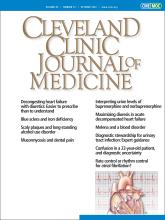Article Figures & Data
Tables
Total urinary buprenorphine (ng/mL)a Total urinary norbuprenorphine (ng/mL)a N:B ratiob Differential or likely diagnosis Scenario 1 > 20 > 45 Usually
> 0.26Recent dosing of at least some buprenorphine Scenario 2 Low, ≤ 20c Low, ≤ 45c Usually
> 0.26Regular recent dosing
Dosing at low levels
Use of a CYP3A4-inducer
Increased time since last dose
Dilute urineScenario 3 Positive, but low Negative or very low < 1 (may be 0) Recent (within hours) dosing of buprenorphine for first time in days Scenario 4 High, usually > 700 Negative 0 Buprenorphine spiking and no recent dosing Scenario 5 High, usually > 700 Positive < 0.26 Probable buprenorphine spiking, likely recent dosing if norbuprenorphine level is not low
Possible regular dosing when N:B ratio > 0.02 but < 0.26↵a Total urinary levels listed here include the parent compound and the glucoronidated form (eg, total buprenorphine = free buprenorphine + buprenorphine- 3-glucoronide) achieved after laboratory hydrolysis.
↵b Some studies suggest using an N:B ratio of 0.02 as a threshold for identifying urine spiked with unconsumed buprenorphine. Using a more sensitive threshold of 0.26 keeps a broader differential.
↵c Some studies consider values < 100 ng/mL to be low.
CYP3A4 = hepatic cytochrome P450 3A4; N:B ratio = ratio of norbuprenorphine to buprenorphine






